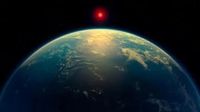On April 17, 2025, the scientific community was abuzz with excitement following the revelation of the most promising signs of life yet detected on the exoplanet K2-18b. The findings, published in the journal Astrophysical Journal Letters, suggest that this distant world, located 124 light-years from Earth, may harbor conditions suitable for life.
The research team, utilizing the advanced capabilities of the James Webb Space Telescope, identified chemical traces of dimethyl sulfide (DMS) and dimethyl disulfide (DMDS) in K2-18b's atmosphere. These molecules are significant as they are produced exclusively by microorganisms on Earth, particularly marine phytoplankton. The detection of such compounds raises intriguing possibilities about the planet's potential for supporting life.
K2-18b is classified as a 'Hycean' planet, a term theorized for the first time in 2021 by the lead author of the study, Professor Nikku Madhusudhan from the University of Cambridge. Hycean planets are characterized by their hydrogen-rich atmospheres and are entirely covered in liquid water, making them candidates for habitability. Madhusudhan and his colleagues believe that K2-18b may possess vast oceans of liquid water, providing a conducive environment for life.
However, while the detection of DMS and DMDS is exciting, Madhusudhan cautioned that these findings do not constitute definitive proof of extraterrestrial life. "The detected molecules could also be produced by some unknown chemical processes on the planet that do not involve life," he explained. This highlights the need for further investigation to confirm the presence of life.
In previous studies, the same team had already detected carbon dioxide and methane in K2-18b's atmosphere using the Near-Infrared Imager of the James Webb Space Telescope. The current findings, derived from observations using the telescope's mid-infrared instrument, build upon this foundational work. Madhusudhan and his co-authors are optimistic that conducting 16 to 24 hours of follow-up observations could yield more data to support their hypotheses.
Despite the optimism surrounding these findings, other experts in the field have expressed caution. Sara Seager, a professor of physics and planetary science at the Massachusetts Institute of Technology (MIT), noted that the interpretations of K2-18b vary significantly among researchers. "There are multiple teams with entirely different interpretations of the planet itself," she stated. Some researchers suggest that K2-18b may have a high-temperature magma ocean, indicating a less habitable environment beneath a hydrogen-rich atmosphere.
Seager's remarks underscore the complexity of planetary science and the ongoing debates within the scientific community regarding K2-18b's potential for life. She emphasized that while the detection of potential biosignatures is intriguing, much more data and time are needed to establish the planet's true nature.
The discovery of K2-18b's potential biosignatures has sparked considerable interest, not only among scientists but also within the general public. The news ranked as the third most significant topic in recent reports, reflecting the growing fascination with the search for extraterrestrial life. As the scientific community continues to explore the cosmos, K2-18b stands out as a beacon of hope in the quest to answer one of humanity's most profound questions: Are we alone in the universe?
As researchers gear up for further studies, the potential for groundbreaking discoveries remains high. The James Webb Space Telescope, with its unprecedented capabilities, is set to play a crucial role in unraveling the mysteries of K2-18b. With ongoing advancements in technology and methodology, the dream of finding life beyond Earth inches closer to reality.
In conclusion, while the recent findings regarding K2-18b are promising, they also serve as a reminder of the complexities involved in the search for extraterrestrial life. The scientific community remains cautiously optimistic, eager to gather more data that could illuminate the mysteries of this distant world. As we continue to explore the universe, each discovery brings us one step closer to understanding our place within it.





